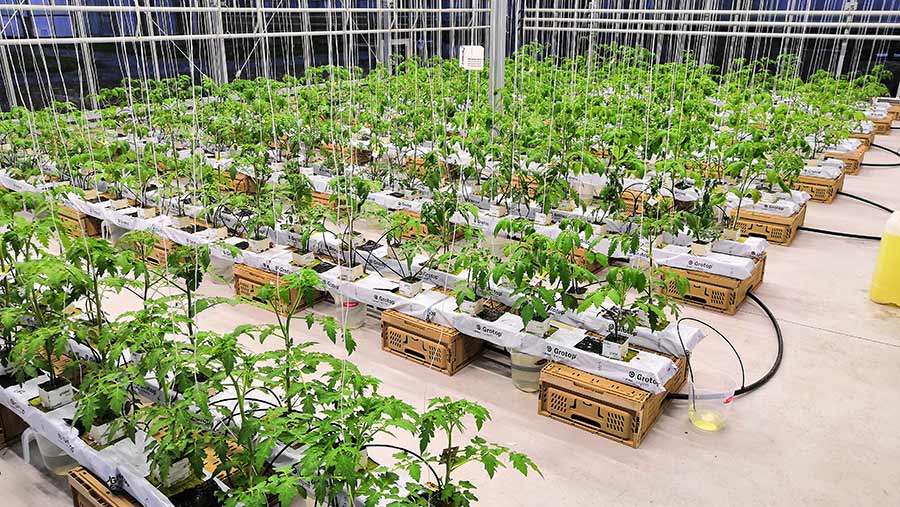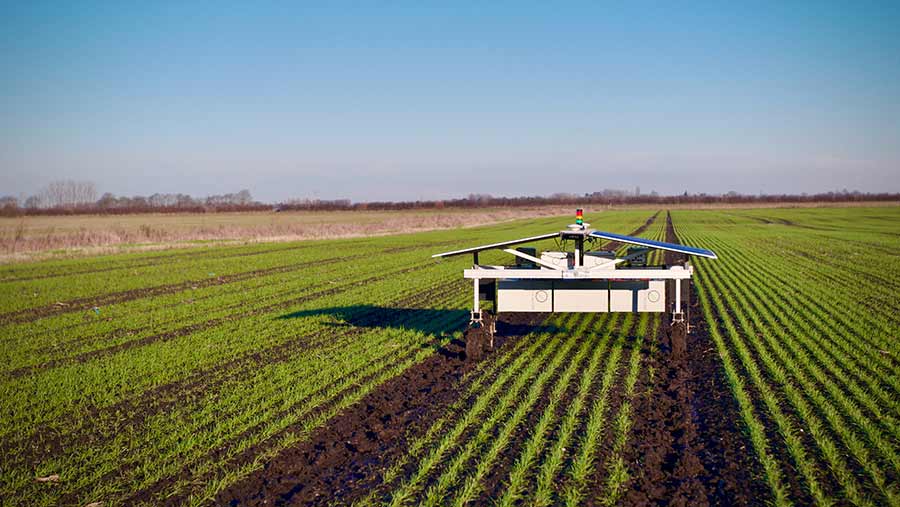Have UK’s Agri-Tech Centres achieved and what’s next?
 © Agri-Tech Centres
© Agri-Tech Centres Change is in the air in the agri-research space, with plans afoot to merge three of the four Agri-Tech Centres to form a single Agri-Tech “Catapult”.
The aim is “to create an innovation ecosystem that will strengthen connections, and accelerate robust, commercially viable and sustainable solutions”.
Sounds like so much gobbledygook? Maybe. But the message is clear – the Agri-Tech Centres are in for a shake-up. So, what’s going on?
The Agri-Tech Centres were established in 2013, with the aim of helping to commercialise new technologies and close the gap on overseas competitors in terms of productivity, where the UK has been lagging for many years.
See also: Can Agri-Tech deliver new ‘golden age’ for farmers?
The four centres created were:
- Agri-EPI Focused on engineering and precision farming technologies
- Chap Majoring on containing crop pests and disease
- Ciel Aiming to lift profitability and productivity in the livestock sector
- Agrimetrics Using agricultural data to build a better food system.
It is the first three of these that are set to merge – the fourth, Agrimetrics, will remain a separate entity.
Nine Catapults
As for Catapults, there are nine of them, established by government agency Innovate UK, operating from more than 50 sites in the UK to help accelerate and scale up new technologies.
Their work areas range from gene therapy and medicines to satellites and renewable energy – providing expertise and facilities for businesses to test, demonstrate and improve their ideas.
Announcing the planned creation of a new Agri-Tech Catapult in late September, science and innovation minister George Freeman pointed to the need to commercialise the UK’s academic research base and so bridge the gap with industry.
“With the global population set to hit nine billion within the next 25 years, we need to double global food production using the same land with half as much energy and water,” he said.
“That is the challenge driving global demand for agri-tech – the technologies that allow us to produce more with less.”
Peter Quinn, who chairs the board overseeing the creation of the new Agri-Tech Catapult, said a new single organisation would “build on the three Agri-Tech Centres’ strong foundations to accelerate innovation, and strengthen the UK’s world-class agri-tech ecosystem”.
Foundations
But just how strong are these foundations?
Tina Barsby, former chief executive of the National Institute of Agricultural Botany, has her doubts, saying there are significant lessons to be learned from the past 10 years.
“The legacy of the centres of innovation is not one of unmitigated success,” she said in a recent article for Science for Sustainable Agriculture.
“Suggestions that the Agri-Tech Centres have played a ‘vital role in translating agricultural innovation into commercial success’ or that they have ‘bolstered food security, reduced our carbon footprint, and enhanced productivity’ are simply not backed up by the evidence.”
Growth in UK agricultural productivity had continued to fall behind other countries, she said, while progress in reducing UK farming’s carbon footprint had remained “stubbornly slow”.
“I would struggle to name specific projects where the three centres have translated agricultural innovation into commercial success over the past decade,” she added.
As a member of the original Agri-Tech Strategy leadership council, Dr Barsby also criticised the “‘capital only” funding model.
“Restricting their ability to invest in anything other than equipment, capital and basic running costs meant the centres were entirely dependent on attracting investment in research projects from commercial partners,” she said.
This has hindered their ability to establish new agri-tech capabilities, or plug gaps in the existing R&D landscape, she argued.

© Agri-Tech Centres
Taking issue
Not surprisingly, the three Agri-Tech Centres take issue with these allegations, particularly in relation to carbon emissions.
“It’s very much a live area,” said Phil Bicknell, director of Ciel. “Across all the Agri-Tech Centres, carbon-related research projects are in progress or in the pipeline.”
One specific example is a project Ciel is involved in, investigating whether cattle methane emissions can be reduced by using a chemical extracted from daffodils.
The Chap Net Zero report also sets out mitigation practices to reduce the global warming impact of UK arable and horticulture crops.
Mr Bicknell also denies that the funding model has hindered the work of the Agri-Tech Centres or made them too dependent on commercial partners.
“Our focus is on creating and facilitating the link between science and industry,” he said.
“That means working with commercial partners, ensuring that research and innovation address real-world problems and provide practical and viable solutions.”
Genetic improvement
But it’s not just about funding. Dr Barsby is also critical of the Agri-Tech Centres’ perceived lack of focus on genetic innovation – a technology that she says can really help with on-farm productivity and efficiency.
“The single most important factor driving on-farm productivity gains is genetic innovation, yet this was not a core focus for any of the centres,” she said.
“Consequently, the John Innes Centre, our flagship genetic institution, has hardly interacted with the centres at all.”
Dr Barsby points to two separate reviews of plant science which both highlighted the need for a more joined-up R&D pipeline for genetic innovation “to transfer promising early-stage discoveries from lab to field”.
This lack of “translational” research is a particular barrier to progressing the one area which could really drive productivity gains for British farming, says Dr Barsby.
“As priorities for the new Agri-Tech Catapult are developed, it seems unthinkable that the importance of translational research in the context of crop genetic innovation could be overlooked yet again.”
Criticism denied
But the criticism is denied, with the Agri-Tech Centres adamant that innovation through genetic technologies is a key strand of activity across all the centres.
They point to a recent pilot study using genetic selection to identify superior, worm-tolerant sheep and breed them into the wider flock.
“Breed for CH4nge” is another industry-wide programme to measure and collect methane emissions data, and breed sheep with a naturally low carbon footprint.
Fraser Black, the chief executive of Chap, said:
“While work on genetic improvement – both conventional and advanced – is a key strand of the work of the centres for both crop and livestock systems, we work in many other aspects of agri-tech such as precision engineering, controlled environment production, and biopesticide development.
“We believe Dr Barsby’s main emphasis is on crop improvement for arable systems which, although important, is only part of the overall focus of the centres.
“Furthermore, productivity is only one measure of success. The Agri-Tech Centres look to provide a range of complementary tools for an integrated effective farming system. Productivity improvement is only one of those tools.”
As ever, it seems, there are two sides to every story – and two scientific opinions for every argument.
What others have said about the Agri-Tech Centres
Daniel Pearsall, co-ordinator of Science for Sustainable Agriculture:
“The Agri-Tech Centres were set up to bridge the chronic neglect of translational research – with the aim of taking the findings of our brilliant UK scientists through to practical technology and on-farm application.
“But the model did not work, due partly to the capital funding limitations and the reluctance to get involved with genetics.
“They have been more conveyors of resource rather than actors. Innovate UK says it has been transformational. The evidence on the ground suggests that it has not.”
Dr Kate Pressland, manager of the Centre for Effective Innovation in Agriculture:
“It has been tricky for the Agri-Tech Centres in the past as they were set up with public money, but with a mandate to bring in commercial income.
“This has made it difficult to deliver impact-driven research aimed at farmers on the ground, and to achieve a measurable return on investment.
“However, they have been very active in applying for funding under Defra’s latest Farming Innovation Programme, putting in lots of bids for producer- and industry-centric projects – but are competing with each other within the same fund. Coming together under one roof makes sense.”
What you need to know about the new Agri-Tech Catapult
What is a Catapult?
Established by the UK’s innovation agency, Innovate UK, the Catapults are a network of technology and innovation hubs.
They are independent, not-for-profit organisations, providing facilities and expertise to other businesses, research bodies and government, to accelerate technical advance.
What are the benefits of creating a new Agri-Tech Catapult?
The aim is to create a new structure that allows for greater cross-sector working in areas such as climate change mitigation, disease control and sustainability.
Sharing knowledge with experts in other areas is seen as a particular benefit.
Will the new Agri-Tech Catapult be any more successful in raising productivity and efficiency?
While the three Agri-Tech Centres are adamant they have done a good job, they see the creation of the Agri-Tech Catapult as putting food and farming on a par with other high-profile sectors, and so more likely to attract government research and investment.
“It positions food and farming as a strategic sector for the UK economy,” said a spokesman.
What will happen to Chap, Ciel and Agri-EPI?
The centres will continue operating until the new merged business is implemented in April 2024.
All current workstreams and projects will be maintained until then, and some may be transferred to the new Catapult.
Will there still be an equal focus on all crops, livestock and engineering?
The new merged business will maintain a focus on all three areas, as well as exploring new sectors within the wider area of food, feed, fuel and fibres.
